The 1–31-Day Predictions of the South China Sea Summer Monsoon in the CAMS-CSM Climate Forecast System
Abstract
:1. Introduction
2. Data and Method
2.1. Model Description
2.2. Observational Data
2.3. SCSSM Attributes and Verification Metrics
3. Results
3.1. Predictions of Dynamic and Thermodynamic Variables
3.2. Predictions of SCSSM Indices and the Onset Date
3.3. Case Study
4. Conclusions and Discussion
Supplementary Materials
Author Contributions
Funding
Institutional Review Board Statement
Informed Consent Statement
Data Availability Statement
Acknowledgments
Conflicts of Interest
References
- Ding, Y. Summer Monsoon Rainfalls in China. J. Meteorol. Soc. Jpn. Ser. II 1992, 70, 373–396. [Google Scholar] [CrossRef] [Green Version]
- Kong, W.; Chiang, J.C.H. Interaction of the Westerlies with the Tibetan Plateau in Determining the Mei-Yu Termination. J. Clim. 2020, 33, 339–363. [Google Scholar] [CrossRef] [Green Version]
- Tao, S.; Chen, L. A review of recent research of the east Asian summer monsoon in China. In Monsoon Meteorology; Chang, C.-P., Krishnamurti, T.N., Eds.; Oxford University Press: New York, NY, USA, 1987; pp. 60–92. [Google Scholar]
- Ding, Y.; Chan, J. The East Asian Summer Monsoon: An Overview. Meteorol. Atmos. Phys. 2005, 89, 117–142. [Google Scholar] [CrossRef]
- Ding, Y.; Liu, Y. Onset and the evolution of the Summer Monsoon over the South China Sea during SCSMEX Field Experiment in 1998. J. Meteorol. Soc. Jpn. Ser. II 1999, 79, 255–276. [Google Scholar] [CrossRef] [Green Version]
- Huang, R.H.; Xu, Y.; Wang, P.; Zhou, L. The features of the catastrophic flood over the Changjiang River Basin during the summer of 1998 and cause exploration. Clim. Environ. Res. 1998, 3, 300–313. (In Chinese) [Google Scholar] [CrossRef]
- Shao, X.; Huang, P.; Huang, R. A review of the South China Sea summer monsoon onset. Adv. Earth Sci. 2014, 29, 1126–1137. (In Chinese) [Google Scholar] [CrossRef]
- He, J.; Wen, M.; Shi, X.; Zhao, Q. Splitting and eastward withdrawal of the subtropical high belt during the onset of the South China Sea summer monsoon and their possible mechanism. J. Nanjing Univ. Nat. Sci. Ed. 2002, 38, 318–330. (In Chinese) [Google Scholar]
- Wang, B.; Huang, F.; Wu, Z.; Yang, J.; Fu, X.; Kikuchi, K. Multi-Scale Climate Variability of the South China Sea Monsoon: A Review. Dyn. Atmos. Ocean. 2009, 47, 15–37. [Google Scholar] [CrossRef]
- Liu, B.; Zhu, C. A Possible Precursor of the South China Sea Summer Monsoon Onset: Effect of the South Asian High: SAH Leads the Onset of the SCSSM. Geophys. Res. Lett. 2016, 43, 11072–11079. [Google Scholar] [CrossRef]
- Li, C.; Yanai, M. The Onset and Interannual Variability of the Asian Summer Monsoon in Relation to Land–Sea Thermal Contrast. J. Clim. 1996, 9, 358–375. [Google Scholar] [CrossRef] [Green Version]
- Wu, R.; Wang, B. Interannual Variability of Summer Monsoon Onset over the Western North Pacific and the Underlying Processes. J. Clim. 2000, 13, 2483–2501. [Google Scholar] [CrossRef]
- Wang, B.; Wu, R.; Lau, K.-M. Interannual Variability of the Asian Summer Monsoon: Contrasts between the Indian and the Western North Pacific–East Asian Monsoons. J. Clim. 2001, 14, 4073–4090. [Google Scholar] [CrossRef]
- Kwon, M.; Jhun, J.; Wang, B.; An, S.; Kug, J. Decadal Change in Relationship between East Asian and WNP Summer Monsoons. Geophys. Res. Lett. 2005, 32, L16709. [Google Scholar] [CrossRef] [Green Version]
- Krishnamurti, T. Summer Monsoon Experiment—A Review. Mon. Weather Rev. 1985, 113, 1590–1626. [Google Scholar] [CrossRef] [Green Version]
- Murakami, T. Empirical Orthogonal Function Analysis of Satellite-Observed Outgoing Longwave Radiation During Summer. Mon. Weather Rev. 1980, 108, 205–222. [Google Scholar] [CrossRef] [Green Version]
- Wu, G.; Zhang, Y. Tibetan Plateau Forcing and the Timing of the Monsoon Onset over South Asia and the South China Sea. Mon. Weather Rev. 1998, 126, 913–927. [Google Scholar] [CrossRef]
- Huang, R.; Sun, F. Impacts of the thermal state and the convective activities in the tropical western warm pool on the summer climate anomalies in East Asia. Chin. J. Atmos. Sci. 1994, 18, 141–151. (In Chinese) [Google Scholar]
- Huang, R.; Sun, F. Impact of the convective activities over the western Tropical Pacific warm pool on the intraseasonal variability of the East Asian summer monsoon. Chin. J. Atmos. Sci. 1994, 18, 456–465. (In Chinese) [Google Scholar]
- Wu, G.; Liu, Y.; He, B.; Bao, Q.; Duan, A.; Jin, F.-F. Thermal Controls on the Asian Summer Monsoon. Sci. Rep. 2012, 2, 404. [Google Scholar] [CrossRef] [Green Version]
- Huang, R.; Chen, J.; Wang, L.; Lin, Z. Characteristics, Processes, and Causes of the Spatio-Temporal Variabilities of the East Asian Monsoon System. Adv. Atmos. Sci. 2012, 29, 910–942. [Google Scholar] [CrossRef]
- Fan, Y.; Fan, K.; Xu, Z.; Li, S. ENSO–South China Sea Summer Monsoon Interaction Modulated by the Atlantic Multidecadal Oscillation. J. Clim. 2018, 31, 3061–3076. [Google Scholar] [CrossRef]
- You, J.; Jian, M.; Gao, S.; Cai, J. Interdecadal Change of the Winter-Spring Tropospheric Temperature Over Asia and its Impact on the South China Sea Summer Monsoon Onset. Front. Earth Sci. 2021, 8, 661–675. [Google Scholar] [CrossRef]
- Vitart, F.; Ardilouze, C.; Bonet, A.; Brookshaw, A.; Chen, M.; Codorean, C.; Déqué, M.; Ferranti, L.; Fucile, E.; Fuentes, M.; et al. The Subseasonal to Seasonal (S2S) Prediction Project Database. Bull. Am. Meteorol. Soc. 2017, 98, 163–173. [Google Scholar] [CrossRef]
- Li, Q.; Yang, S.; Wu, T.; Liu, X. Subseasonal Dynamical Prediction of East Asian Cold Surges. Weather Forecast. 2017, 32, 1675–1694. [Google Scholar] [CrossRef]
- Brunet, G.; Shapiro, M.; Hoskins, B.; Moncrieff, M.; Dole, R.; Kiladis, G.N.; Kirtman, B.; Lorenc, A.; Mills, B.; Morss, R.; et al. Collaboration of the Weather and Climate Communities to Advance Subseasonal-to-Seasonal Prediction. Bull. Am. Meteorol. Soc. 2010, 91, 1397–1406. [Google Scholar] [CrossRef]
- Rong, X.; Li, J.; Chen, H.; Xin, Y.; Su, J.; Hua, L.; Zhou, T.; Qi, Y.; Zhang, Z.; Zhang, G.; et al. The CAMS Climate System Model and a BasicEvaluation of Its Climatology and Climate Variability Simulation. J. Meteorol. Res. 2018, 32, 839–861. [Google Scholar] [CrossRef]
- Liu, B.; Su, J.; Ma, L.; Tang, Y.; Rong, X.; Li, J.; Chen, H.; Liu, B.; Hua, L.; Wu, R. Seasonal Prediction Skills in the CAMS-CSM Climate Forecast System. Clim. Dyn. 2021, 57, 2953–2970. [Google Scholar] [CrossRef]
- Kanamitsu, M.; Ebisuzaki, W.; Woollen, J.; Yang, S.-K.; Hnilo, J.J.; Fiorino, M.; Potter, G.L. NCEP–DOE AMIP-II Reanalysis (R-2). Bull. Am. Meteorol. Soc. 2002, 83, 1631–1644. [Google Scholar] [CrossRef]
- Hersbach, H.; Bell, B.; Berrisford, P.; Hirahara, S.; Horányi, A.; Muñoz-Sabater, J.; Nicolas, J.; Peubey, C.; Radu, R.; Schepers, D.; et al. The ERA5 Global Reanalysis. Q. J. R. Meteorol. Soc. 2020, 146, 1999–2049. [Google Scholar] [CrossRef]
- He, M. Summer monsoon and Yangtze River basin precipitation (Abstract). In Preprint of Abstracts of Papers for the First WNO International Workshop on Monsoon Studies; WMO: Geneva, Switzerland, 1997; Volume 786, pp. 67–67B. [Google Scholar]
- Li, C.; Zhang, L. Summer monsoon activities in the South China Sea and its impacts. Chin. J. Atmos. Sci. 1999, 23, 257–266. [Google Scholar] [CrossRef]
- Wang, B.; Lin, H.; Zhang, Y.; Lu, M.-M. Definition of South China Sea Monsoon Onset and Commencement of the East Asia Summer Monsoon. J. Clim. 2004, 17, 699–710. [Google Scholar] [CrossRef] [Green Version]
- Dai, N.; Xie, A.; Zhang, Y. Interannual and interdecadal variations of summer monsoon activities over South China Sea. Clim. Environ. Res. 2000, 5, 363–374. [Google Scholar]
- Jin, L.; Zhao, P. Observational and modeling studies of impacts of the South China Sea monsoon on the monsoon rainfall in the middle-lower reaches of the Yangtze River during summer. Acta Meteorol. Sin. 2012, 26, 176–188. [Google Scholar] [CrossRef]
- Xie, A.; Liu, X.; Ye, Q. Equatorial vortex and the onset of summer monsoon over the South China Sea. Acta Meteorol. Sin. 1997, 55, 611–619. (In Chinese) [Google Scholar]
- Li, J.; Zhang, L. Wind Onset and Withdrawal of Asian Summer Monsoon and Their Simulated Performance in AMIP Models. Clim. Dyn. 2009, 32, 935–968. [Google Scholar] [CrossRef]
- Wang, Q.; Ding, Y. Climatological aspects of evolution of summer monsoon over the northern South China Sea. Acta Meteorol. Sin. 1997, 55, 466–483. [Google Scholar]
- Huangfu, J.; Huang, R.; Chen, W. Relationship between the South China Sea Summer Monsoon Onset and Tropical Cyclone Genesis over the Western North Pacific. Int. J. Climatol. 2017, 37, 5206–5210. [Google Scholar] [CrossRef]
- Zhu, Z.; Li, T. Empirical Prediction of the Onset Dates of South China Sea Summer Monsoon. Clim. Dyn. 2017, 48, 1633–1645. [Google Scholar] [CrossRef]
- Liu, B.; Zhu, C. Subseasonal-to-Seasonal Predictability of Onset Dates of South China Sea Summer Monsoon: A Perspective of Meridional Temperature Gradient. J. Clim. 2021, 34, 5601–5616. [Google Scholar] [CrossRef]
- Xu, J.; Koldunov, N.; Remedio, A.R.C.; Sein, D.V.; Zhi, X.; Jiang, X.; Xu, M.; Zhu, X.; Fraedrich, K.; Jacob, D. On the Role of Horizontal Resolution over the Tibetan Plateau in the REMO Regional Climate Model. Clim. Dyn. 2018, 51, 4525–4542. [Google Scholar] [CrossRef] [Green Version]
- Zhu, S.; Zhi, X.; Ge, F.; Fan, Y.; Zhang, L.; Gao, J. Subseasonal forecast of surface air temperature using superensemble approaches: Experiments over Northeast Asia for 2018. Weather Forecast. 2021, 36, 39–51. [Google Scholar] [CrossRef]
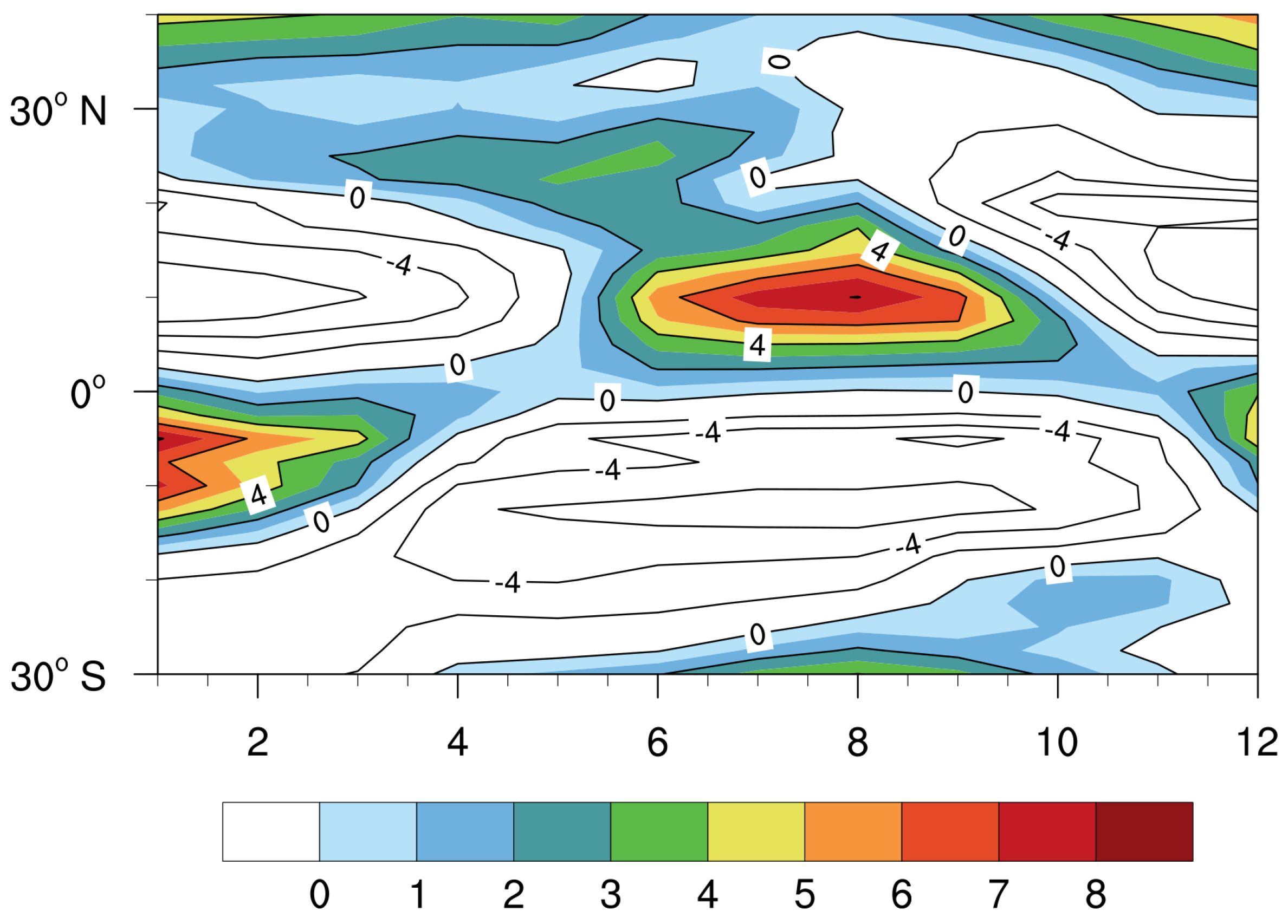

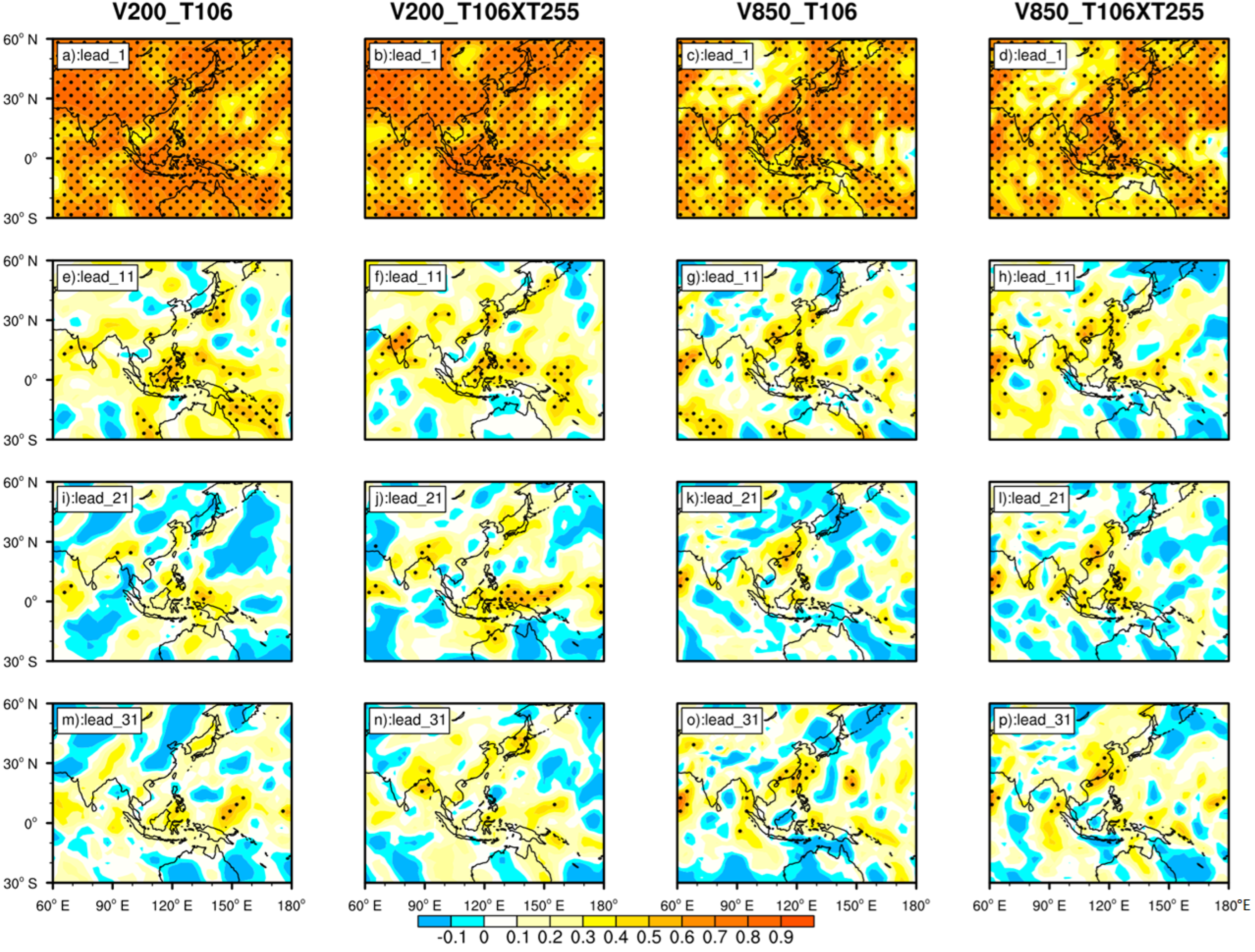


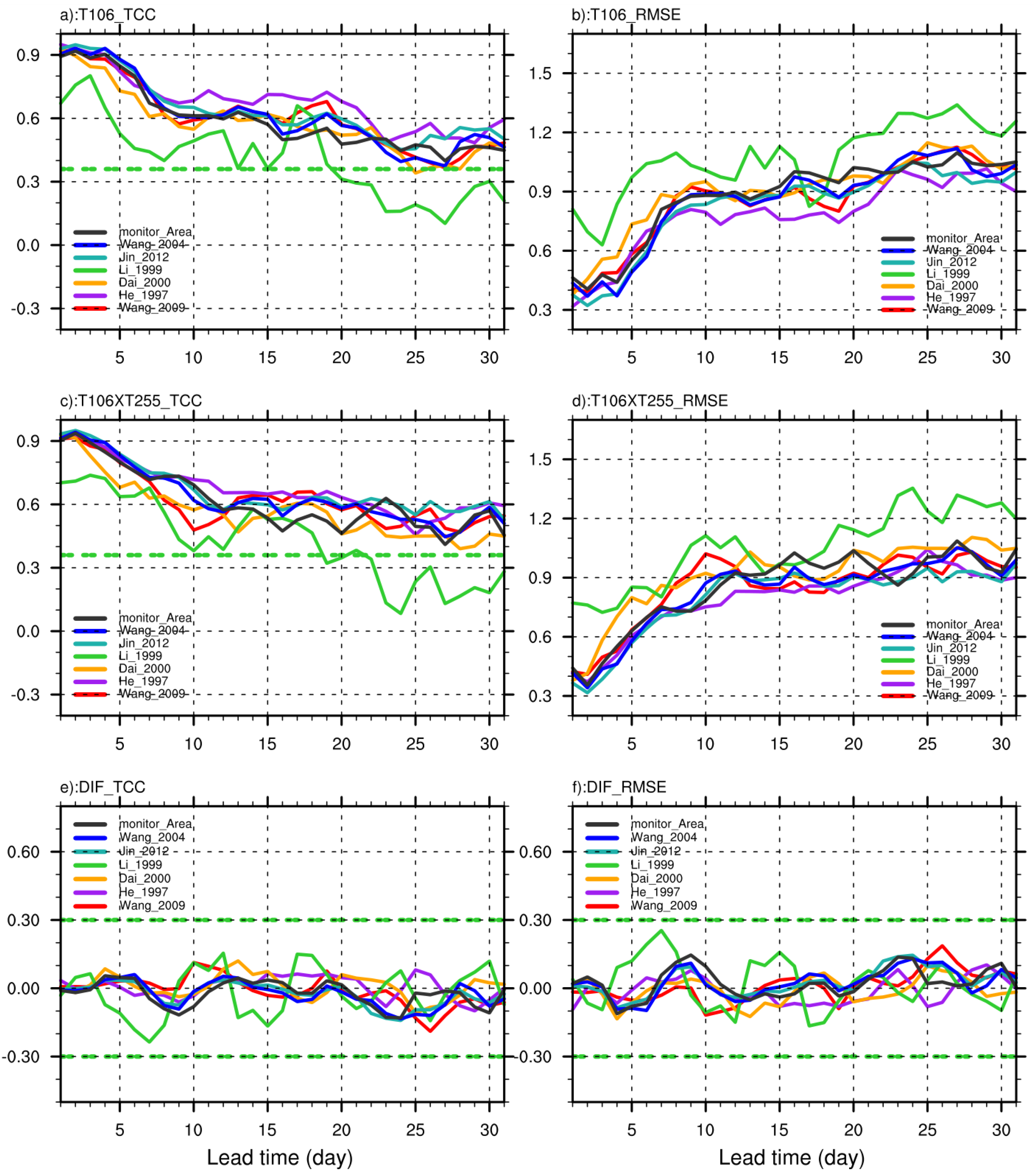

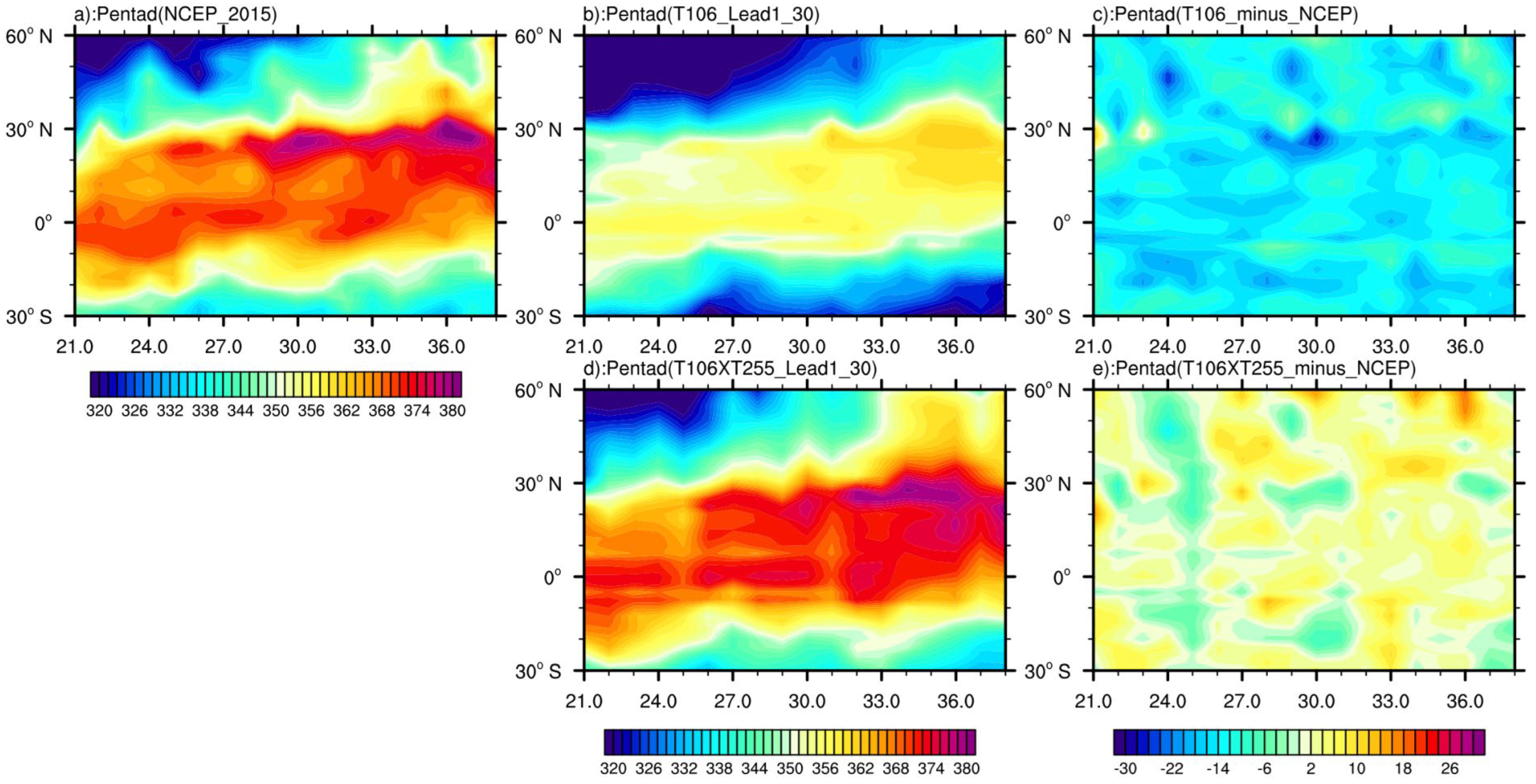
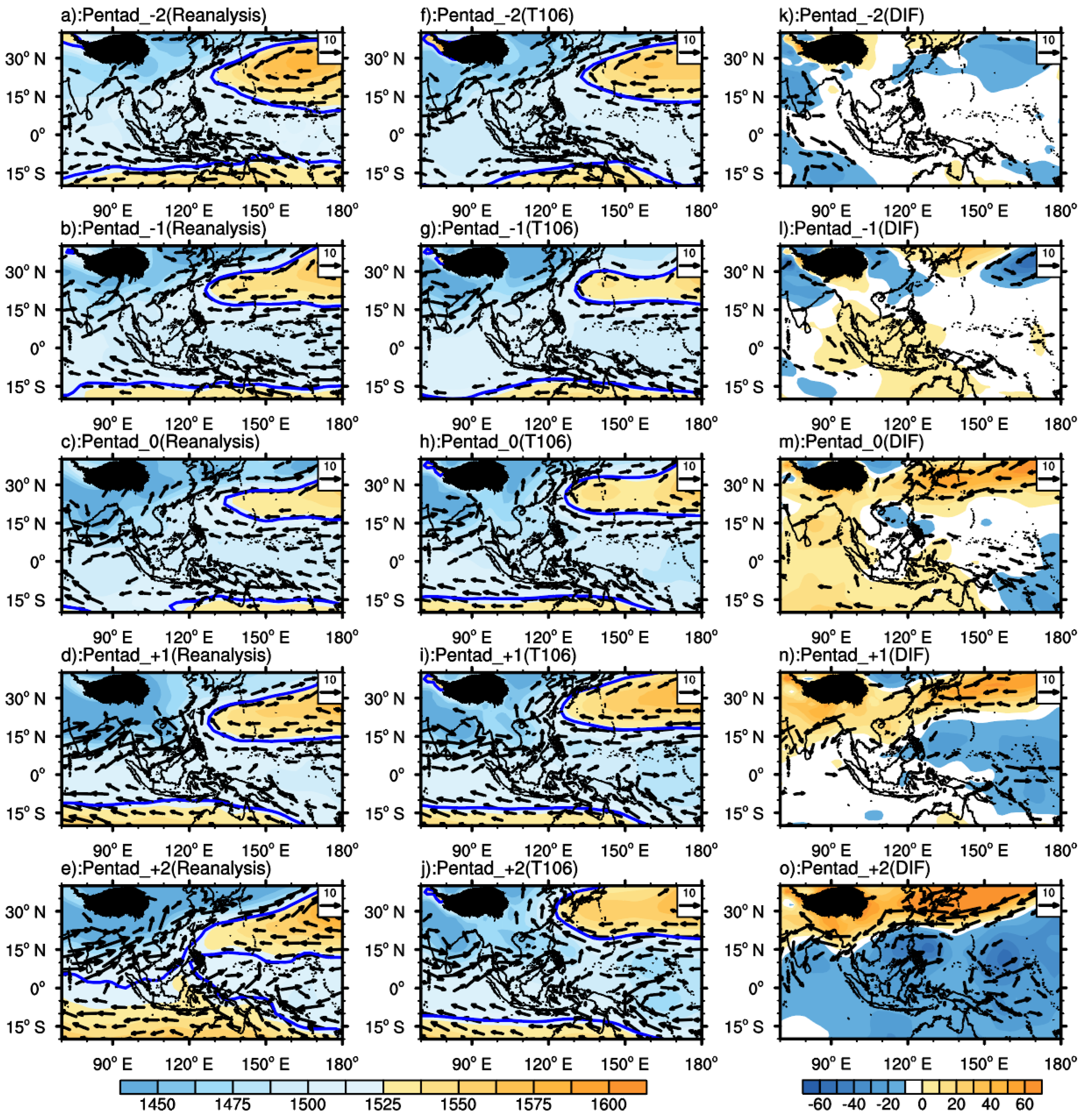

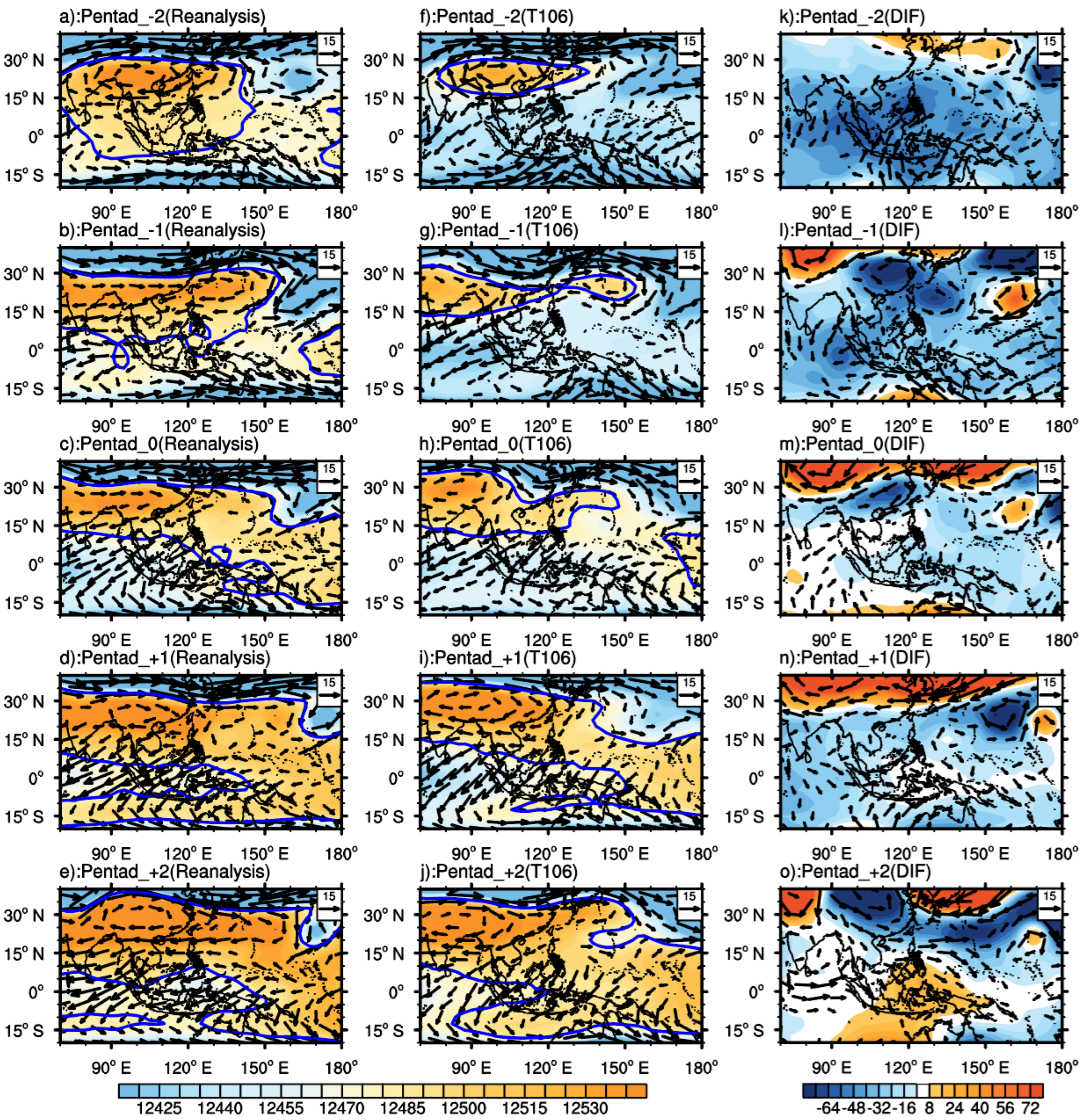
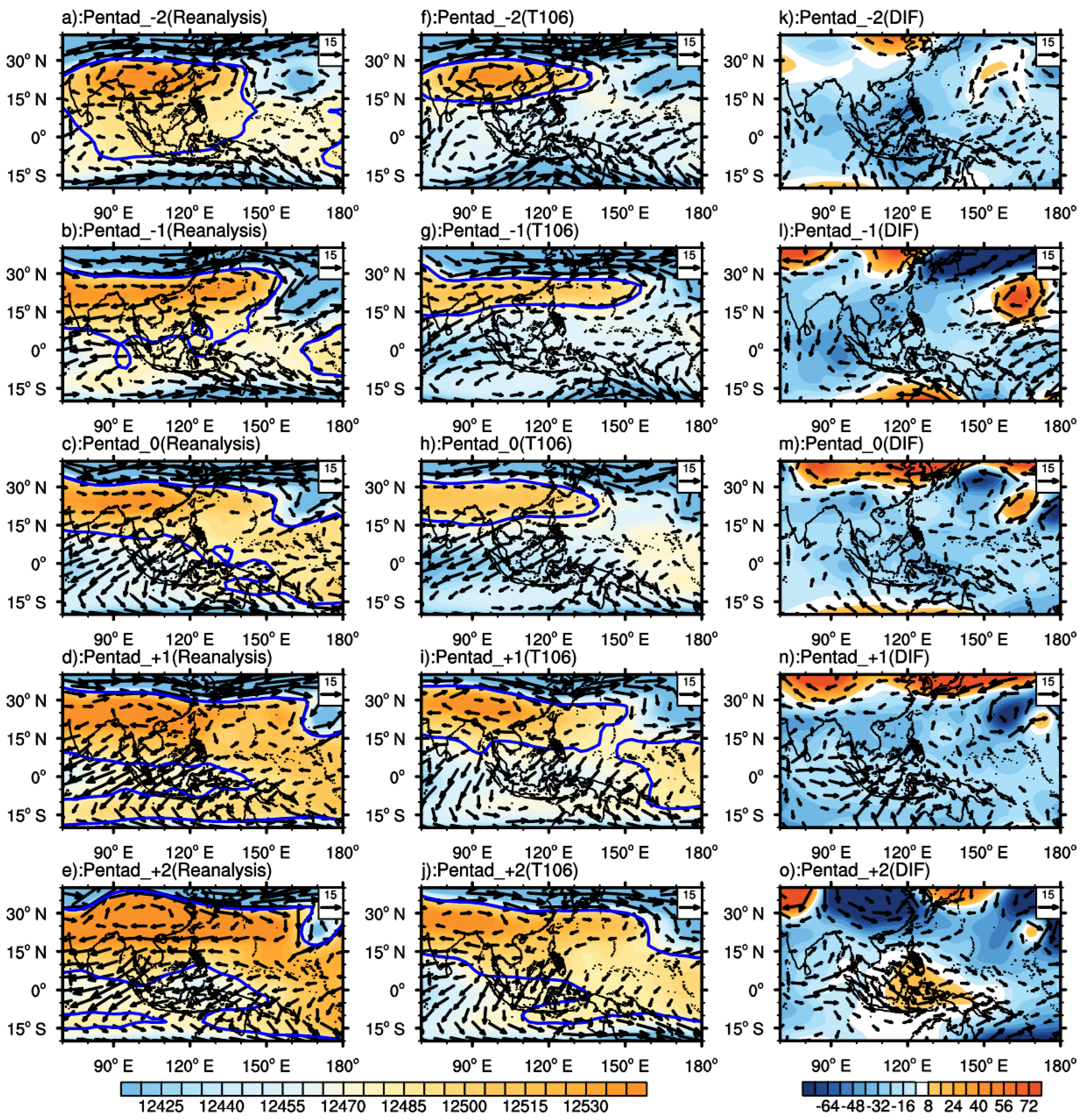
| Sources | Variables and Regions | Calculation Method |
|---|---|---|
| Wang et al. [9] | U, 850 hPa (5–15° N, 110–120° E) (20–25° N, 110–120° E) | The difference of the area average zonal wind between two areas |
| He et al. [31] | U, 200 hPa and 850 hPa (0–10° N, 100–130° E) | U(850 hPa) minus U(200 hPa) |
| Li et al. [32] | UV, 200 hPa/850 hPa (7.5–17.5° N, 105–125° E) | Mean value of divergence difference between two layers on the standardized area |
| Wang et al. [33] | U, 850 hPa (5–15° N, 110–120° E) | The area average of zonal wind |
| Dai et al. [34] | UV, 850 hPa (5–20° N, 105–120° E) | Full wind speed accumulation for each grid point on the standardized area |
| Jin et al. [35] | U, 850 hPa (5–17.5° N, 100–130° E) | The area average of zonal wind |
| CMA | U, 850 hPa (5°–15° N, 110°–120° E) | The area average of zonal wind |
Publisher’s Note: MDPI stays neutral with regard to jurisdictional claims in published maps and institutional affiliations. |
© 2022 by the authors. Licensee MDPI, Basel, Switzerland. This article is an open access article distributed under the terms and conditions of the Creative Commons Attribution (CC BY) license (https://creativecommons.org/licenses/by/4.0/).
Share and Cite
Wang, X.; Fan, Y.; Wang, L.; Zhu, Y. The 1–31-Day Predictions of the South China Sea Summer Monsoon in the CAMS-CSM Climate Forecast System. Atmosphere 2022, 13, 1051. https://doi.org/10.3390/atmos13071051
Wang X, Fan Y, Wang L, Zhu Y. The 1–31-Day Predictions of the South China Sea Summer Monsoon in the CAMS-CSM Climate Forecast System. Atmosphere. 2022; 13(7):1051. https://doi.org/10.3390/atmos13071051
Chicago/Turabian StyleWang, Xin, Yi Fan, Lijuan Wang, and Yan Zhu. 2022. "The 1–31-Day Predictions of the South China Sea Summer Monsoon in the CAMS-CSM Climate Forecast System" Atmosphere 13, no. 7: 1051. https://doi.org/10.3390/atmos13071051
APA StyleWang, X., Fan, Y., Wang, L., & Zhu, Y. (2022). The 1–31-Day Predictions of the South China Sea Summer Monsoon in the CAMS-CSM Climate Forecast System. Atmosphere, 13(7), 1051. https://doi.org/10.3390/atmos13071051





